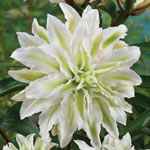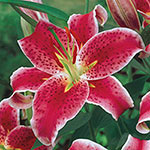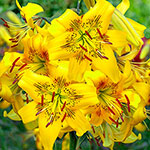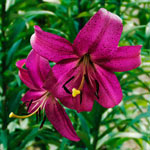Lily Bulbs
While there are many varieties of lilies available, all lilies have an elegant look that comprises of large, brilliantly colored triangular petals that open wide and curl back to reveal delicate stamen in the center of the bloom. Not only are the colors delightful, but the fragrance produced by lily flowers can be downright intoxicating. Planting lily bulbs in your garden is a great way to ensure you can enjoy their beautiful blooms for years to come. Shop our selection of lily bulbs for sale today!
Cultivate Elegant Blooms in Your Garden With Lily Bulbs
Lilium is a genus of herbaceous flowering plants growing from bulbs, all with large prominent flowers. Breck's has years of experience in selling top-quality lily plants and other summer bulbs. We offer a plethora of colors and types, from exotic-looking Stargazer lilies with painted petals speckled in both light and dark dots, to elegant white lilies that sparkle with pure white petals and red stamens. For more planting information, read our growing tips for lily flowers.When Do I Plant Lily Flowers?
Fall is a great time for planting lilies. Lily "bulbs" are actually tubers composed of fleshy scales and lack a protective covering. Unlike true bulb flowers, they never go completely dormant and should be handled carefully since they loose moisture very quickly. Essentially, you can plant your new lilies anytime before the ground freezes. Lily bulbs can also be planted in the spring.With so many varieties of lily bulbs to choose from, your yard could be a colourful display of beautiful blooming flowers throughout the summer months. Planting lilies in succession with other plants will give your garden splashes of colour all summer long with minimal maintenance—regardless of whether you choose Asiatic lilies that are fragrance free and bloom in midsummer, or very fragrant Oriental lilies that bloom in mid to late summer. There are thousands of lily plant varieties and hybrids on the market today. Some of our most popular varieties include Tiger Lilies, Oriental lilies, and Trumpet Lilies.
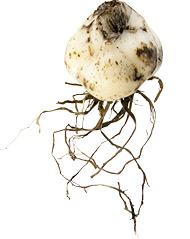
Where Do I Plant Lilies?
The most natural location for lilies is on sloping ground with excellent drainage. It's a good idea to place them with other low plants which can provide shade for the bulb and root system. For best results, plant your lilies where they will have a mix of some leaf mold or compost in the soil. Lilies prefer to have their blooms in the sun and their roots in the shade. Try planting them among annuals or perennials that will keep their roots cool.How to Plant Lilies
Prepare the soil with large amounts of organic matter such as leaf mold or compost. Plant with the roots downward and the scales upward. After planting, water well two or three times before freezing. Lilies are most effective when planted in groups of three or more. Space them about a foot apart—they will spread and fill this space in no time!Lily FAQs
What Do You Do After Lily Bulbs Finish Flowering?
Once lily plants have finished flowering, they should be removed as soon as they fade. Blooms left in place will produce seed, which diverts energy from flower production and plant growth. The flowers can be cut or pinched off. Alternatively, you can cut the stalks when the blooms first open and use them in floral arrangements.Always allow the leaves on the stalk to turn yellow and fall off as part of the lily plant's natural growth process. This ensures that the bulbous underground part of the plant has gotten enough nourishment and will mean greater growth next year. Each year watch their beauty increase as they multiply!
Lilies grown in pots can be easily salvaged and re-planted. Deadhead spent flowers, and allow the greenery to die back before digging up the bulbs. Cut back on watering after blooming. Once the foliage has died back, dig up the bulbs from the pot. Separate as needed, and allow your bulbs to dry out on sheets of paper or in paper bags for a few days before storing the bulbs. You can replant them in the garden, or wait until next year to use in new container displays!
What Do Lilies Symbolize?
The name lilium comes from a Greek world leírion, generally assumed to refer to white lilies—and that reference the white lilies of myth ties directly to the symbolism of these flowers.Lilies symbolize purity, hope, and rebirth. Their association with renewal and rebirth make lilies popular in funeral services, and in Easter arrangements. In Greek mythology, lilies are associated with the goddess of family and marriage. Lilies are often gifted in the celebration of anything new—weddings, new babies, and even the simple joy of springtime.
Do Lilies Like Sun or Shade?
Nearly all lilies are true sun plants. Lilies perform best when they receive full sunlight for at least six to eight hours per day. Japanese lilies and some Asiatic varieties can handle a bit of dappled light or shade, however, they may not bloom as frequently without full sun.Do Lilies Come Back Every Year?
Liles do return each year, often growing taller and spreading a bit as they become established until they reach mature height. There are winter-hardy lilies available to bloom in nearly all parts of the United States, so check the hardiness zone of your lilies, and choose a variety that will bring you joy year after year.Lilies grown in pots can be easily salvaged and re-planted. Deadhead spent flowers, and allos the greenery to die back before digging up the bulbs. Cut back on watering after blooming. Once the foliage has died back, dig up the bulbs from the pot. Separate as needed, and allow your bulbs to dry out on sheets of paper or in paper bags for a few days before storing the bulbs. You can replant them in the garden, or wait until next year to use in new container displays!
How Do You Take Care of a Lily Plant?
Not only are lilies gorgeous, they're easy to care for. Give them their best start by planting your lilies in a location with full sun and good drainage, considering both height and width as you choose a spot with adequate space for their mature size. Since lilies naturally grow in clumps, consider planting a grouping together for a naturalized look!Throughout your lilys' blooming season, they'll require regular watering, ensuring at least an inch or two of water each week. Water your lilies in the morning, and water at the base. Watering the petals can increase the risk of fungal infestation or pests.
A light, balanced fertilizer may encourage blooming, so use floral fertilizer on your lilies just before they bloom, and again afterward—especially if they are of a reblooming variety. Deadhead your lilies after they've bloomed, but don't cut back the leaves and stems until they begin to die back on their own.
Every few years, divide your lilies to avoid overcrowding. Dig up your lily bulbs in fall, and look for new clumps forming along the main bulb. Pull those new clumps off carefully. You can dispose of them, or you can plant them in a new location for more attractive springtime flowers.








